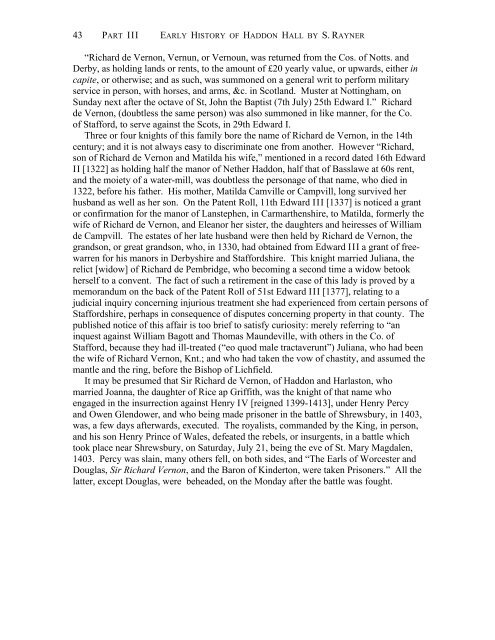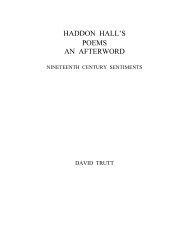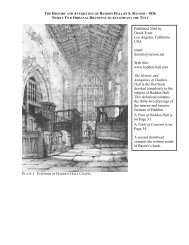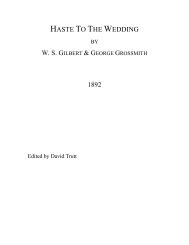Download - Haddon Hall
Download - Haddon Hall
Download - Haddon Hall
You also want an ePaper? Increase the reach of your titles
YUMPU automatically turns print PDFs into web optimized ePapers that Google loves.
43 PART III EARLY HISTORY OF HADDON HALL BY S. RAYNER<br />
“Richard de Vernon, Vernun, or Vernoun, was returned from the Cos. of Notts. and<br />
Derby, as holding lands or rents, to the amount of £20 yearly value, or upwards, either in<br />
capite, or otherwise; and as such, was summoned on a general writ to perform military<br />
service in person, with horses, and arms, &c. in Scotland. Muster at Nottingham, on<br />
Sunday next after the octave of St, John the Baptist (7th July) 25th Edward I.” Richard<br />
de Vernon, (doubtless the same person) was also summoned in like manner, for the Co.<br />
of Stafford, to serve against the Scots, in 29th Edward I.<br />
Three or four knights of this family bore the name of Richard de Vernon, in the 14th<br />
century; and it is not always easy to discriminate one from another. However “Richard,<br />
son of Richard de Vernon and Matilda his wife,” mentioned in a record dated 16th Edward<br />
II [1322] as holding half the manor of Nether <strong>Haddon</strong>, half that of Basslawe at 60s rent,<br />
and the moiety of a water-mill, was doubtless the personage of that name, who died in<br />
1322, before his father. His mother, Matilda Camville or Campvill, long survived her<br />
husband as well as her son. On the Patent Roll, 11th Edward III [1337] is noticed a grant<br />
or confirmation for the manor of Lanstephen, in Carmarthenshire, to Matilda, formerly the<br />
wife of Richard de Vernon, and Eleanor her sister, the daughters and heiresses of William<br />
de Campvill. The estates of her late husband were then held by Richard de Vernon, the<br />
grandson, or great grandson, who, in 1330, had obtained from Edward III a grant of freewarren<br />
for his manors in Derbyshire and Staffordshire. This knight married Juliana, the<br />
relict [widow] of Richard de Pembridge, who becoming a second time a widow betook<br />
herself to a convent. The fact of such a retirement in the case of this lady is proved by a<br />
memorandum on the back of the Patent Roll of 51st Edward III [1377], relating to a<br />
judicial inquiry concerning injurious treatment she had experienced from certain persons of<br />
Staffordshire, perhaps in consequence of disputes concerning property in that county. The<br />
published notice of this affair is too brief to satisfy curiosity: merely referring to “an<br />
inquest against William Bagott and Thomas Maundeville, with others in the Co. of<br />
Stafford, because they had ill-treated (“eo quod male tractaverunt”) Juliana, who had been<br />
the wife of Richard Vernon, Knt.; and who had taken the vow of chastity, and assumed the<br />
mantle and the ring, before the Bishop of Lichfield.<br />
It may be presumed that Sir Richard de Vernon, of <strong>Haddon</strong> and Harlaston, who<br />
married Joanna, the daughter of Rice ap Griffith, was the knight of that name who<br />
engaged in the insurrection against Henry IV [reigned 1399-1413], under Henry Percy<br />
and Owen Glendower, and who being made prisoner in the battle of Shrewsbury, in 1403,<br />
was, a few days afterwards, executed. The royalists, commanded by the King, in person,<br />
and his son Henry Prince of Wales, defeated the rebels, or insurgents, in a battle which<br />
took place near Shrewsbury, on Saturday, July 21, being the eve of St. Mary Magdalen,<br />
1403. Percy was slain, many others fell, on both sides, and “The Earls of Worcester and<br />
Douglas, Sir Richard Vernon, and the Baron of Kinderton, were taken Prisoners.” All the<br />
latter, except Douglas, were beheaded, on the Monday after the battle was fought.







